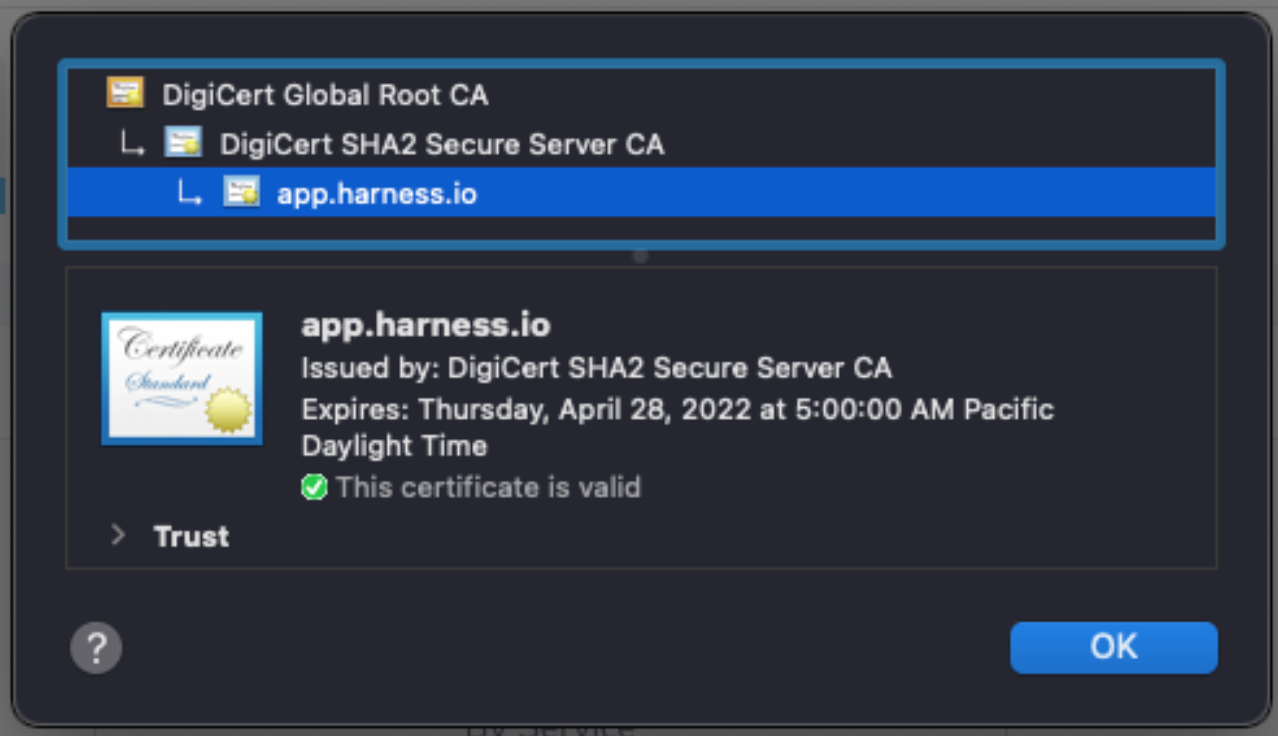Truststore override for delegates
Harness Delegates perform most Harness tasks. Delegates make outbound TLS/SSL connections to the Harness SaaS platform to obtain these task assignments. The TLS/SSL connection from the delegate to Harness requires a trusted certificate.
Harness Delegate ships with a Java Runtime Environment (JRE) that includes a default trusted certificate in its truststore (located at /etc/pki/java/cacerts). This truststore uses multiple trusted certificates. You can limit the number you use based on your company security protocols.
The JRE truststore must include the certificate that delegates require to establish trust with Harness (app.harness.io).
This topic describes how to limit the truststore used with Harness Delegates and ensure the trusted certificate Harness requires is included in the delegate truststore.
Before you begin
Required: Harness trusted certificate
TLS/SSL communication between the Harness Delegate and Harness SaaS uses a certificate from the DigiCert Global Root CA:

For delegates to communicate with Harness, this root CA certificate must be installed in the delegate truststore.
The public CA for the certificate is available for download:
-----BEGIN CERTIFICATE-----
MIIDrzCCApegAwIBAgIQCDvgVpBCRrGhdWrJWZHHSjANBgkqhkiG9w0BAQUFADBh
MQswCQYDVQQGEwJVUzEVMBMGA1UEChMMRGlnaUNlcnQgSW5jMRkwFwYDVQQLExB3
d3cuZGlnaWNlcnQuY29tMSAwHgYDVQQDExdEaWdpQ2VydCBHbG9iYWwgUm9vdCBD
QTAeFw0wNjExMTAwMDAwMDBaFw0zMTExMTAwMDAwMDBaMGExCzAJBgNVBAYTAlVT
MRUwEwYDVQQKEwxEaWdpQ2VydCBJbmMxGTAXBgNVBAsTEHd3dy5kaWdpY2VydC5j
b20xIDAeBgNVBAMTF0RpZ2lDZXJ0IEdsb2JhbCBSb290IENBMIIBIjANBgkqhkiG
9w0BAQEFAAOCAQ8AMIIBCgKCAQEA4jvhEXLeqKTTo1eqUKKPC3eQyaKl7hLOllsB
CSDMAZOnTjC3U/dDxGkAV53ijSLdhwZAAIEJzs4bg7/fzTtxRuLWZscFs3YnFo97
nh6Vfe63SKMI2tavegw5BmV/Sl0fvBf4q77uKNd0f3p4mVmFaG5cIzJLv07A6Fpt
43C/dxC//AH2hdmoRBBYMql1GNXRor5H4idq9Joz+EkIYIvUX7Q6hL+hqkpMfT7P
T19sdl6gSzeRntwi5m3OFBqOasv+zbMUZBfHWymeMr/y7vrTC0LUq7dBMtoM1O/4
gdW7jVg/tRvoSSiicNoxBN33shbyTApOB6jtSj1etX+jkMOvJwIDAQABo2MwYTAO
BgNVHQ8BAf8EBAMCAYYwDwYDVR0TAQH/BAUwAwEB/zAdBgNVHQ4EFgQUA95QNVbR
TLtm8KPiGxvDl7I90VUwHwYDVR0jBBgwFoAUA95QNVbRTLtm8KPiGxvDl7I90VUw
DQYJKoZIhvcNAQEFBQADggEBAMucN6pIExIK+t1EnE9SsPTfrgT1eXkIoyQY/Esr
hMAtudXH/vTBH1jLuG2cenTnmCmrEbXjcKChzUyImZOMkXDiqw8cvpOp/2PV5Adg
06O/nVsJ8dWO41P0jmP6P6fbtGbfYmbW0W5BjfIttep3Sp+dWOIrWcBAI+0tKIJF
PnlUkiaY4IBIqDfv8NZ5YBberOgOzW6sRBc4L0na4UU+Krk2U886UAb3LujEV0ls
YSEY1QSteDwsOoBrp+uvFRTp2InBuThs4pFsiv9kuXclVzDAGySj4dzp30d8tbQk
CAUw7C29C79Fv1C5qfPrmAESrciIxpg0X40KPMbp1ZWVbd4=
-----END CERTIFICATE-----
This topic describes how to import this certificate into a new truststore.
Third-party certificates
Harness Delegate also connects to the third-party tools you use with Harness. You should also include those certificates in the delegate truststore.
For example, to pull a Docker image from an artifact server like Nexus or DockerHub, the truststore must include the certificates that those tools require.
Step 1: Stop the delegate
You don't need to stop the Kubernetes delegate. You can run kubectl apply after you update the Kubernetes delegate YAML file.
Step 2: Create truststore with the Harness trusted certificate
Let's walk through the steps of creating a new truststore and importing the Harness trusted certificate.
Copy the following public CA to a file and save it.
-----BEGIN CERTIFICATE-----
MIIDrzCCApegAwIBAgIQCDvgVpBCRrGhdWrJWZHHSjANBgkqhkiG9w0BAQUFADBh
MQswCQYDVQQGEwJVUzEVMBMGA1UEChMMRGlnaUNlcnQgSW5jMRkwFwYDVQQLExB3
d3cuZGlnaWNlcnQuY29tMSAwHgYDVQQDExdEaWdpQ2VydCBHbG9iYWwgUm9vdCBD
QTAeFw0wNjExMTAwMDAwMDBaFw0zMTExMTAwMDAwMDBaMGExCzAJBgNVBAYTAlVT
MRUwEwYDVQQKEwxEaWdpQ2VydCBJbmMxGTAXBgNVBAsTEHd3dy5kaWdpY2VydC5j
b20xIDAeBgNVBAMTF0RpZ2lDZXJ0IEdsb2JhbCBSb290IENBMIIBIjANBgkqhkiG
9w0BAQEFAAOCAQ8AMIIBCgKCAQEA4jvhEXLeqKTTo1eqUKKPC3eQyaKl7hLOllsB
CSDMAZOnTjC3U/dDxGkAV53ijSLdhwZAAIEJzs4bg7/fzTtxRuLWZscFs3YnFo97
nh6Vfe63SKMI2tavegw5BmV/Sl0fvBf4q77uKNd0f3p4mVmFaG5cIzJLv07A6Fpt
43C/dxC//AH2hdmoRBBYMql1GNXRor5H4idq9Joz+EkIYIvUX7Q6hL+hqkpMfT7P
T19sdl6gSzeRntwi5m3OFBqOasv+zbMUZBfHWymeMr/y7vrTC0LUq7dBMtoM1O/4
gdW7jVg/tRvoSSiicNoxBN33shbyTApOB6jtSj1etX+jkMOvJwIDAQABo2MwYTAO
BgNVHQ8BAf8EBAMCAYYwDwYDVR0TAQH/BAUwAwEB/zAdBgNVHQ4EFgQUA95QNVbR
TLtm8KPiGxvDl7I90VUwHwYDVR0jBBgwFoAUA95QNVbRTLtm8KPiGxvDl7I90VUw
DQYJKoZIhvcNAQEFBQADggEBAMucN6pIExIK+t1EnE9SsPTfrgT1eXkIoyQY/Esr
hMAtudXH/vTBH1jLuG2cenTnmCmrEbXjcKChzUyImZOMkXDiqw8cvpOp/2PV5Adg
06O/nVsJ8dWO41P0jmP6P6fbtGbfYmbW0W5BjfIttep3Sp+dWOIrWcBAI+0tKIJF
PnlUkiaY4IBIqDfv8NZ5YBberOgOzW6sRBc4L0na4UU+Krk2U886UAb3LujEV0ls
YSEY1QSteDwsOoBrp+uvFRTp2InBuThs4pFsiv9kuXclVzDAGySj4dzp30d8tbQk
CAUw7C29C79Fv1C5qfPrmAESrciIxpg0X40KPMbp1ZWVbd4=
-----END CERTIFICATE-----
In this example, we'll name the file DigiCertGlobalRootCA.pem.
Run the following command to create a truststore:
keytool -import -file DigiCertGlobalRootCA.pem -alias DigiCertRootCA -keystore trustStore.jks
The above command will ask for a password. You can choose your own password.
This command creates a file named trustStore.jks and imports DigiCert global root CA certificate.
Note where the trustStore.jks file is located. You will provide this path to the delegate as an environment variable.
Step 3: Add third-party certificates to the truststore
You should import any certificates required by the third-party tools you use with Harness.
In most cases, you can navigate to the third-party tool's website portal and download the certificate using a Copy or Export button in the browser. Save the certificate as a PEM (.pem) file and import it into the truststore.
To add multiple certificates in the trustStore.jks file you created, run the keytool -import command multiple times with the different aliases and certificate PEM files for the certificates you are importing.
Step 4: Update the delegate JAVA_OPTS environment variable
Update the delegate JAVA_OPTS environment variable to point to the location of the new truststore file.
Kubernetes delegate
Edit the Kubernetes delegate YAML file. It's named harness-delegate.yaml.
Open the delegate YAML file in a text editor.
In the Deployment specification, locate the env field, and then find the JAVA_OPTS environment variable.
Here's what the default setting looks like:
...
apiVersion: apps/v1
kind: StatefulSet
...
spec:
...
spec:
...
env:
- name: JAVA_OPTS
value: "-XX:+UnlockExperimentalVMOptions -XX:+UseCGroupMemoryLimitForHeap -XX:MaxRAMFraction=2 -Xms64M"
...
Update the JAVA_OPTS environment variable with the location of the new trustStore.jks file and the password.
For example:
...
env:
- name: JAVA_OPTS
value: "-XX:+UnlockExperimentalVMOptions -XX:+UseCGroupMemoryLimitForHeap -XX:MaxRAMFraction=2 -Xms64M -Djavax.net.ssl.trustStore=<path/to/trustStore.jks> -Djavax.net.ssl.trustStoreType=jks -Djavax.net.ssl.trustStorePassword=<password>"
...
Next, you can apply the delegate YAML file, described in the next step.
Step 5: Start the delegate
Now that the JAVA_OPTS environment variable is updated, you can start the delegate.
Kubernetes delegate
Apply the Kubernetes delegate YAML file you edited:
kubectl apply -f harness-delegate.yaml
The delegate starts and appears on the Harness Delegates page.